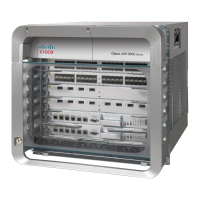139
Cisco ASR 9000 Series Aggregation Services Router Getting Started Guide
OL-28417-02
Troubleshooting the Cisco IOS XR Software
Basic Troubleshooting Commands
Examples
The following example shows how the route for an IP address appears:
RP/0/RSP0/CPU0:router# traceroute 10.233.233.233
Mon May 31 23:55:23.034 DST
Type escape sequence to abort.
Tracing the route to 10.233.233.233
1 ce28 (172.29.52.1) 2 msec 1 msec 0 msec
2 172.24.114.17 0 msec 0 msec 0 msec
3 172.24.114.17 !A * !A
Using the debug Commands
Debug commands are used to diagnose and resolve network problems. Use debug commands to
troubleshoot specific problems or during troubleshooting sessions.
Use debug commands to turn on or off debugging for a specific service or subsystem. When debugging
is turned on for a service, a debug message is generated each time the debugging code section is entered.
The following sections provide information on debugging:
• Displaying a List of Debug Features, page 139
• Enabling Debugging for a Feature, page 141
• Disabling Debugging for a Service, page 142
• Displaying Debugging Status, page 141
• Disabling Debugging for All Services Started at the Active Terminal Session, page 142
• Disabling Debugging for All Services Started at All Terminal Sessions, page 142
Caution Debug commands can generate a large amount of output and can render the system unusable. Use the
debug commands to troubleshoot specific problems or during specific troubleshooting sessions on
systems that are not in production.
Displaying a List of Debug Features
To display a list of the available debug features, enter the debug mode and enter a ? for on-screen help.
The set of debug mode features is different in EXEC and administration EXEC modes. In the following
example, EXEC mode is the entry point to debug mode:
RP/0/RSP0/CPU0:router# debug
RP/0/RSP0/CPU0:router(debug)# ?
IntCtrl Debug IntCtrl Driver
MgmtMultilink MgmtMultilink controller debugging
aaa AAA Authentication, Authorization and Accounting
access-list Debug ethernet-services access-lists
accounting Turn on Accounting debug
adjacency platform AIB information
afmon-ea debug afmon-ea services
afmon-lib debug afmon client library specific function calls
afmon-ma Debug afmon-ma services

